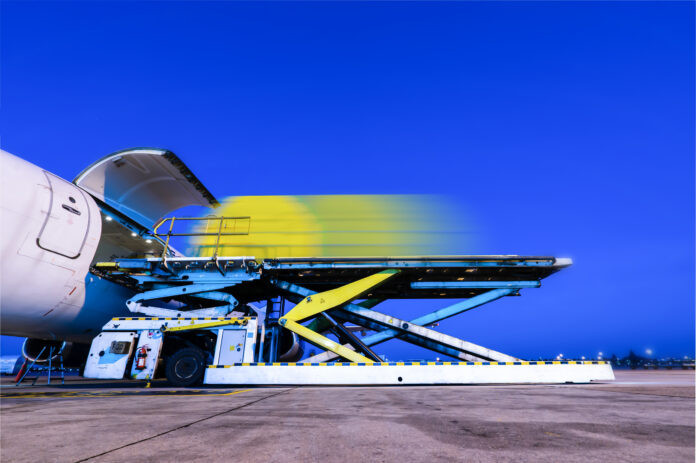

Worldwide air cargo demand in January so far remains significantly up compared with this time last year, according to the latest figures from WorldACD Market Data, with tonnages from all the main global regions ahead of last year’s figures with the exception of ex-North America traffic. Freight forwarders continue to report anecdotally that certain cargo owners are switching some Asia-Europe cargo from sea to air or to sea-air because of longer ocean voyages caused by the disruptions in the Red Sea, although from a data perspective it is difficult to separate this traffic from the normal seasonal mid-January uplift following the New Year slowdown, and from the effects of Lunar New Year (LNY), with LNY in 2024 coming later (10 February) than last year (22 January). Reflecting the serious disruptions to international container shipping, ocean freight spot rates from Asia to Europe are now around three times their level prior to the Red Sea disruptions, although air cargo rates remain relatively stable globally, and ex-Asia Pacific, compared with before the Red Sea crisis – although ex-Asia Pacific air cargo rates had already risen in the final quarter of last year due to seasonal and product-related demand factors. Some forwarders say that in anticipation of ocean to air conversions, they are blocking additional air capacity on core trade lanes to help customers keep their freight moving. Others note that the window for booking air freight ahead of Lunar New Year (10 February) is closing and the next two to three weeks could be challenging, with the expectation of “bunched” container ships arriving en masse at the main European ports, potentially triggering port delays, driver shortages and cargo build-ups at warehouses, driving further traffic towards air cargo. Weekly analysis Meanwhile, preliminary figures for week 3 (15 to 21 January) indicate that global air cargo tonnages rose by a further +5% compared with the previous week, based on the more than 400,000 weekly transactions covered by WorldACD’s data, following a +25% rise in week 2, taking tonnages back up close to their levels in the third week of December and to around 90% of their peak levels in October and November. Average global prices bounced back slightly (+2%) towards their levels at the start of this year. Specific analysis by WorldACD does reveal week-on-week (WoW) increases in tonnages to Europe ex-China (+4%) and ex-Hong Kong (+9%). When comparing with the early December peak, tonnages are exceeding the levels ex-China, but not ex-Hong Kong, while rates on both lanes are -30% lower for the same comparison. Tonnages ex-Gulf Area to Europe were down -17% (WoW), while rates went up by +17%, but both were still below the levels of the beginning of December.Expanding the comparison period to two weeks, total combined tonnages for weeks 2 and 3 this year were up by +26%, globally, compared with the preceding two weeks (2Wo2W) – thanks, largely, to the big post-New Year tonnage bounce-back in week 2. But average rates were down by -2%, on a 2Wo2W basis, with capacity up +3%.Outbound tonnages were up significantly from all the main global regions, on a 2Wo2W basis, with double-digit percentage increases from most origins, including +44% ex-Europe, +29% ex-Central & South America, and +27% ex-North America, with traffic ex-Asia Pacific also rebounding strongly (+22%). This post-New Year rebound also included double-digit percentage tonnage increases on most of the major intercontinental lanes, with only Asia Pacific to North America (+9%) and Asia Pacific to Middle East & South Asia (+5%) in single-digit territory. But average rates were more or less stable, with only ex-Asia Pacific rates (-4%) deviating by more than one or two percentage points, on a regional basis. Year-on-year perspective Year on year (YoY), overall global demand in weeks 2 and 3, combined, is up +6%, compared with the equivalent period last year, despite this period last year benefiting from the early Lunar New Year and the normal surge in air cargo traffic ahead of LNY factory closures in China. The most striking YoY increase is the +21% figure for tonnages ex-Middle East & South Asia (at +12% capacity), which may reflect some conversion of ocean freight to air and sea-air cargo due to the Red Sea disruptions. Traffic ex-Africa was also up strongly (+14%), YoY, and ex-Asia Pacific (+9%) and Central & South America (+9%). Tonnages ex-Europe were up by a more-modest +3%, whereas they remain down ex-North America (-10%), YoY. On the pricing side, average worldwide rates of US$2.35 per kilo in week 3 are -22% below their elevated levels this time last year, although they remain significantly above pre-Covid levels (+32% compared to January 2019). The decline relative to the equivalent period last year includes double-digit YoY percentage drops ex-Europe (-34%), ex-North America (-21%), ex-Asia Pacific (-20%) and ex-Middle East & South Asia (-12%). Average rates ex-Central & South America and ex-Africa remain more stable and were down, YoY, by -5% and -6%, respectively, in weeks 2 and 3 combined. Overall worldwide air cargo capacity remains significantly up on last year’s levels (+12%), including double-digit percentage rises ex-Asia Pacific (+29%), ex-Middle East & South Asia (+12%) and ex-Central & South America (+12%).










